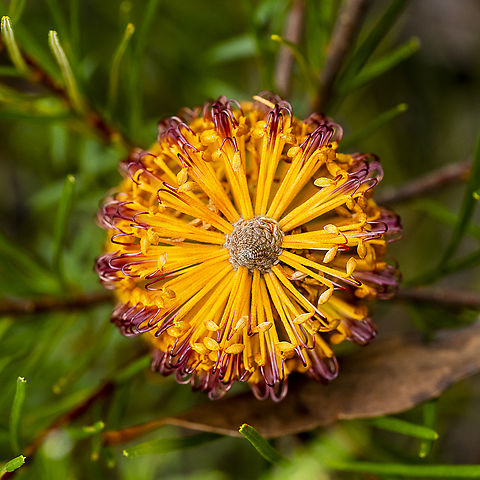
Appearance
The hairpin banksia usually occurs as a multi-stemmed lignotuberous shrub 1–3 metres tall and 1–2 metres across. Alternatively, it may be single-stemmed and lacking a lignotuber, in which case it is often taller, up to 5 metres high. It has grey or grey-brown smooth bark with lenticels.The long, narrow leaves are 3–10 cm in length, 1–8 mm wide and more or less linear in shape. Leaf edges are either serrate for the entire leaf length or toward the apex only, though the margins may be recurved and hence serrations not evident as in those from the Carnarvon Gorge. Immature leaves, which may also be seen after bushfire, are broader and serrated. Leaf undersides have fine white hairs in the case of the varieties "spinulosa" and "collina" and pale brown in "cunninghamii" and "neoanglica".
The distinctive inflorescences or flower spikes occur over a short period through autumn and early winter. A spike may contain hundreds or thousands of individual flowers, each of which consists of a tubular perianth made up of four united tepals, and one long wiry style.
Characteristic of the taxonomic section in which it is placed, the styles are hooked rather than straight. The style ends are initially trapped inside the upper perianth parts, but break free at anthesis. In "Banksia spinulosa" the spikes are cylindrical, about 6–7 centimetres wide and 6–15 centimetres tall, yellow to golden orange in colour, with styles varying from yellow to pink, maroon, or black. Styles of various colours may be found within metres of each other in some areas such as in the Georges River National Park, and Catherine Hill Bay, while other populations may have uniformly black, red or gold styles. Though not terminal, the flower spikes are fairly prominently displayed. Partly emerging from the foliage, they arise from two- to three-year-old stem nodes.
The hairpin banksia's infructescence is a typical "Banksia" cone-like structure, with up to 100 crowded embedded follicles which are 1–2.4 centimetres in diameter; these generally remain closed until burnt by bushfire. The nonlignotuberous subspecies "cunninghamii" is killed by fire and regenerates from seed, while the others regenerate from buds around the base of the lignotuber. Old flower spikes fade to brown, then grey with age. Old flower parts usually persist for a long time, giving the infructescence a hairy appearance. In Central and North Queensland, old cones of both var. "spinulosa" and var. "collina" are generally bare.

Distribution
The hairpin banksia occurs along the east coast of Australia from the Dandenong Ranges east of Melbourne, Victoria, north through New South Wales and into Queensland. It is common north to Maryborough, with disjunct populations occurring as far north as the Atherton Tableland near Cairns. It occurs in a variety of habitats, from coastal heath and elevated rocky slopes to inland dry sclerophyll forest dominated by eucalypts, where they form part of the understorey. Plants in exposed areas are generally considerably shorter than those in sheltered areas. It usually occurs on sand, but can be found in rocky clays or loams."Banksia spinulosa" var. "cunninghamii" is found in three disjunct regions; the Dandenong Ranges east of Melbourne, East Gippsland between Lakes Entrance and Eden, and in the Great Dividing Range in a band from Jervis Bay to Glen Davis in Central New South Wales, while there have been collections northwards in the Dividing Range up into southeast Queensland. It can be an understorey plant under dense as well as open forest cover.
References:
Some text fragments are auto parsed from Wikipedia.